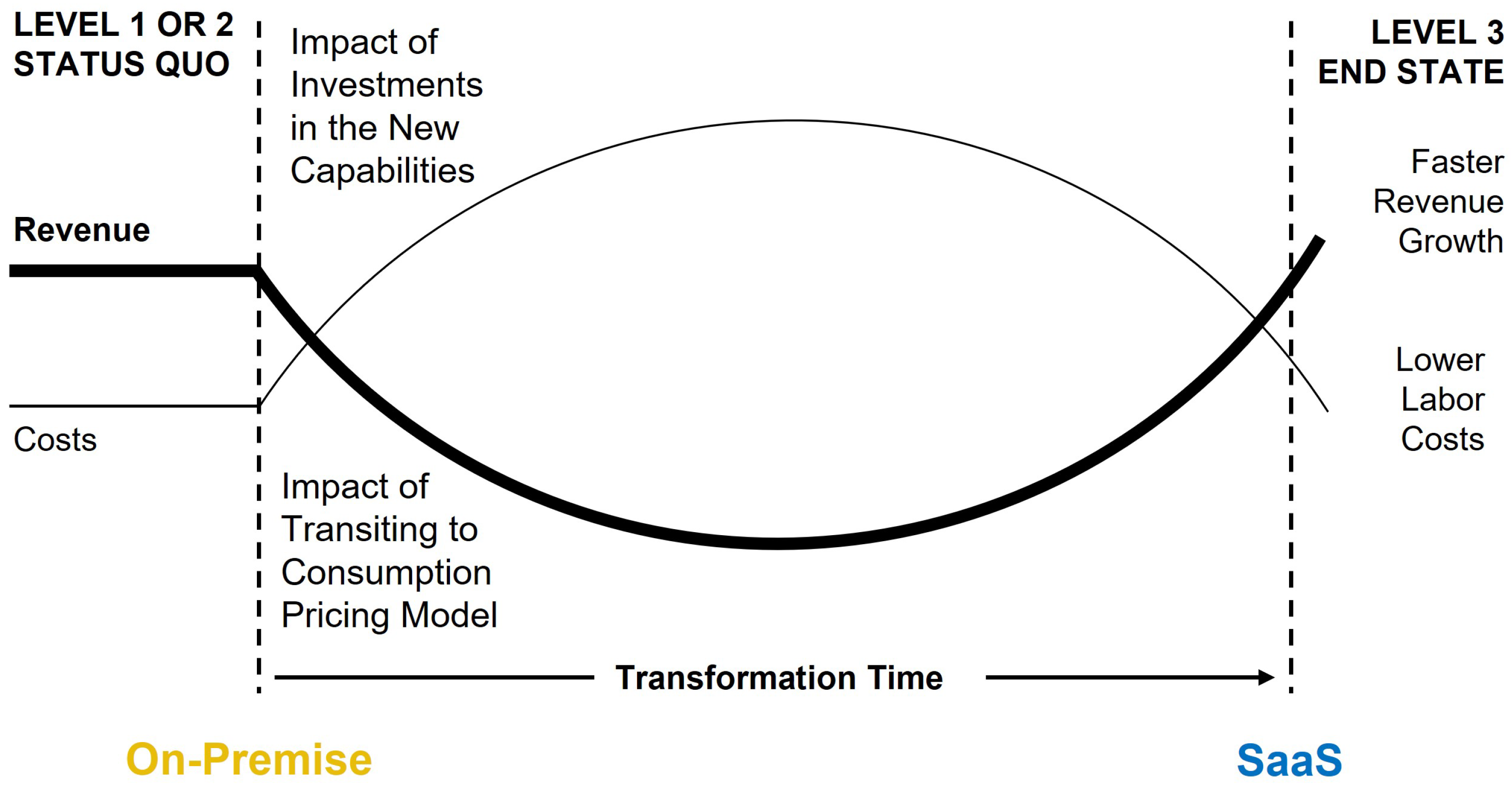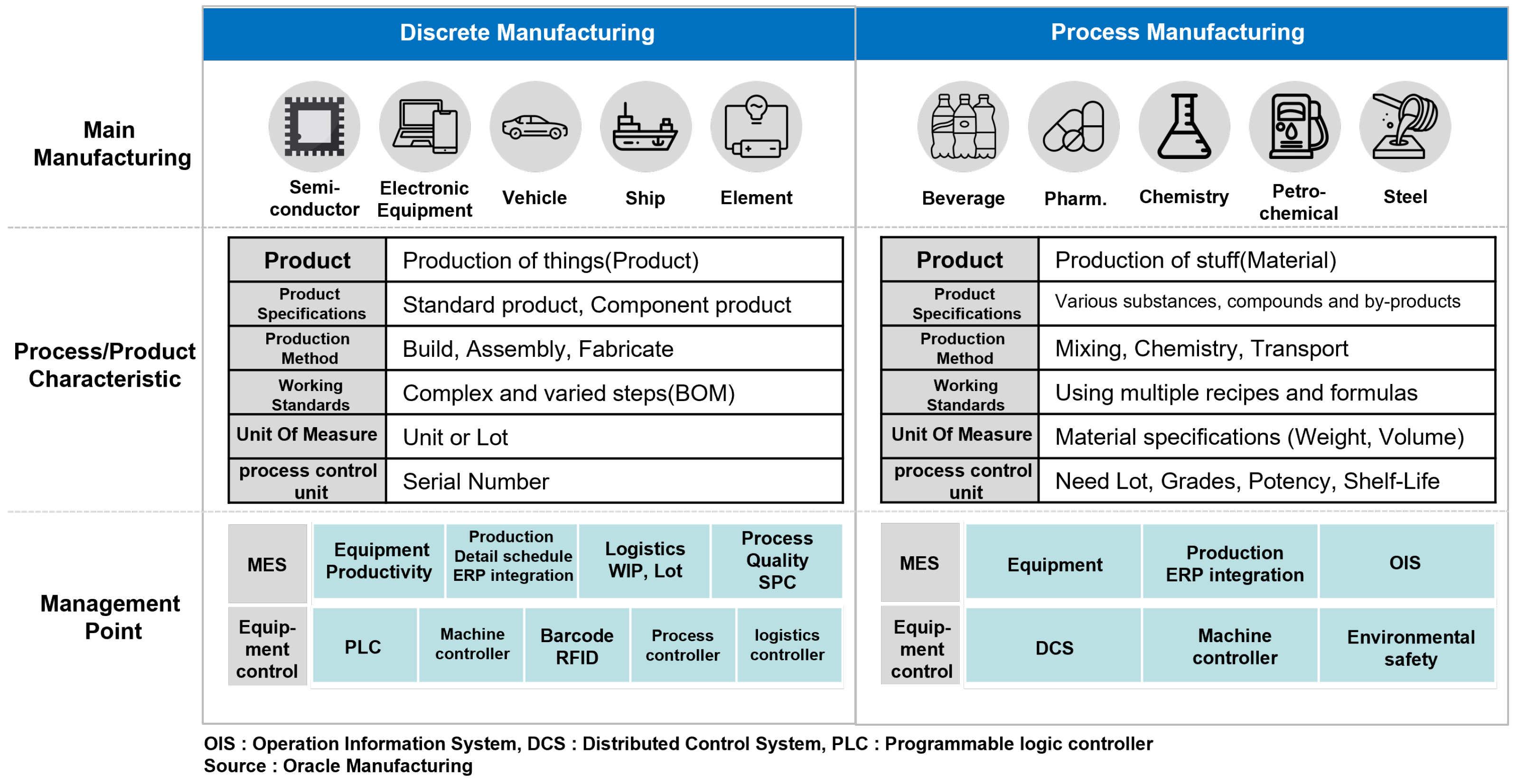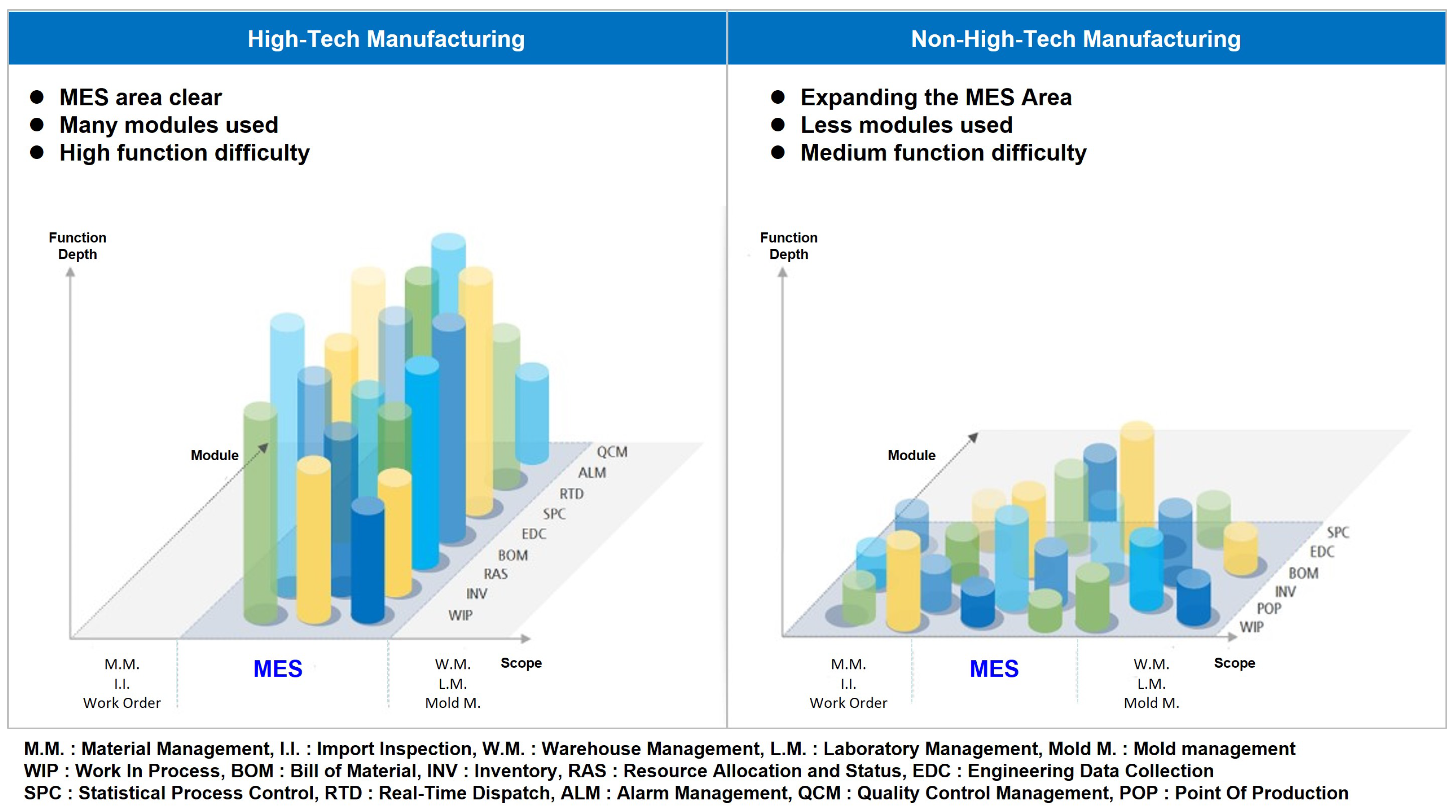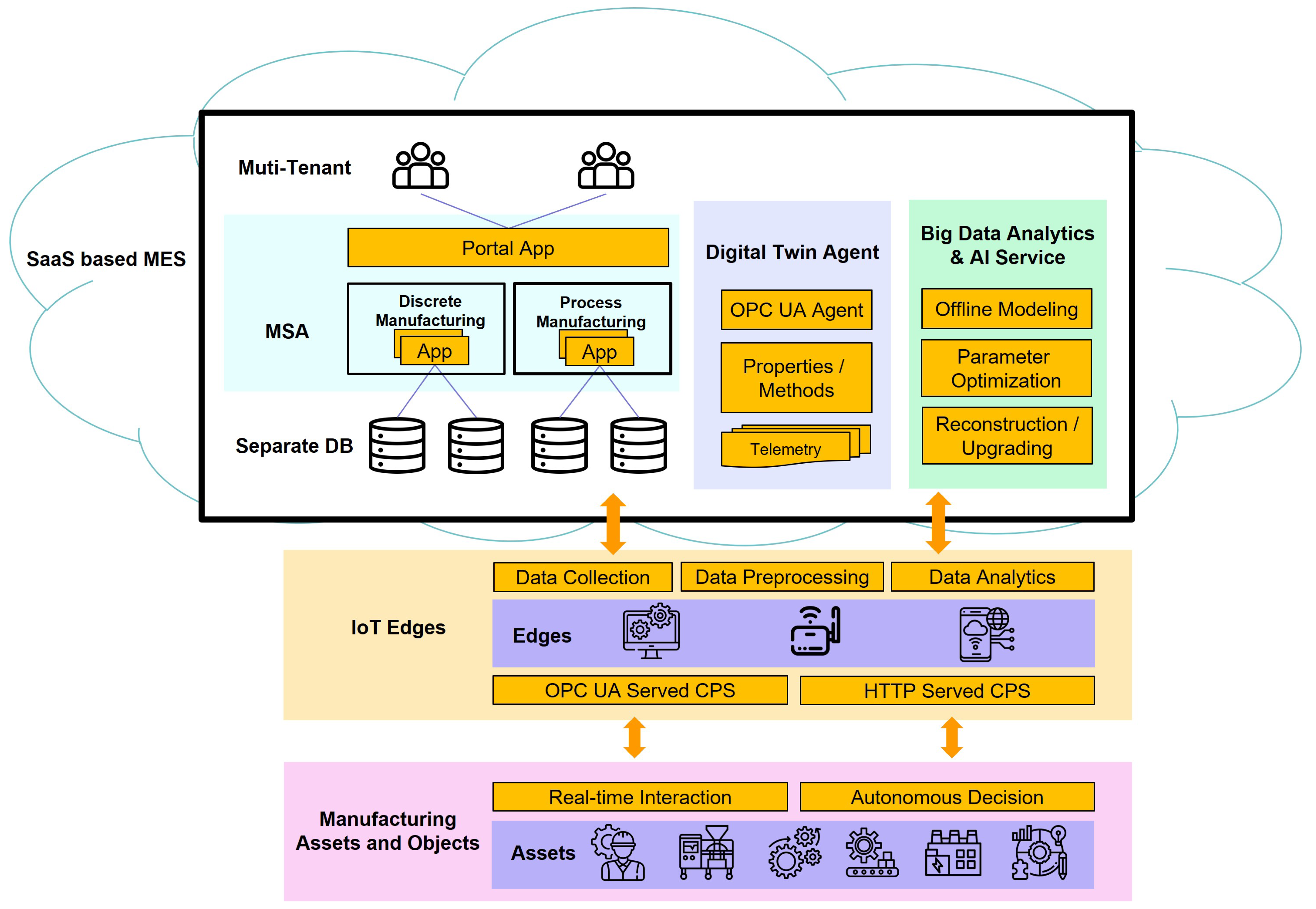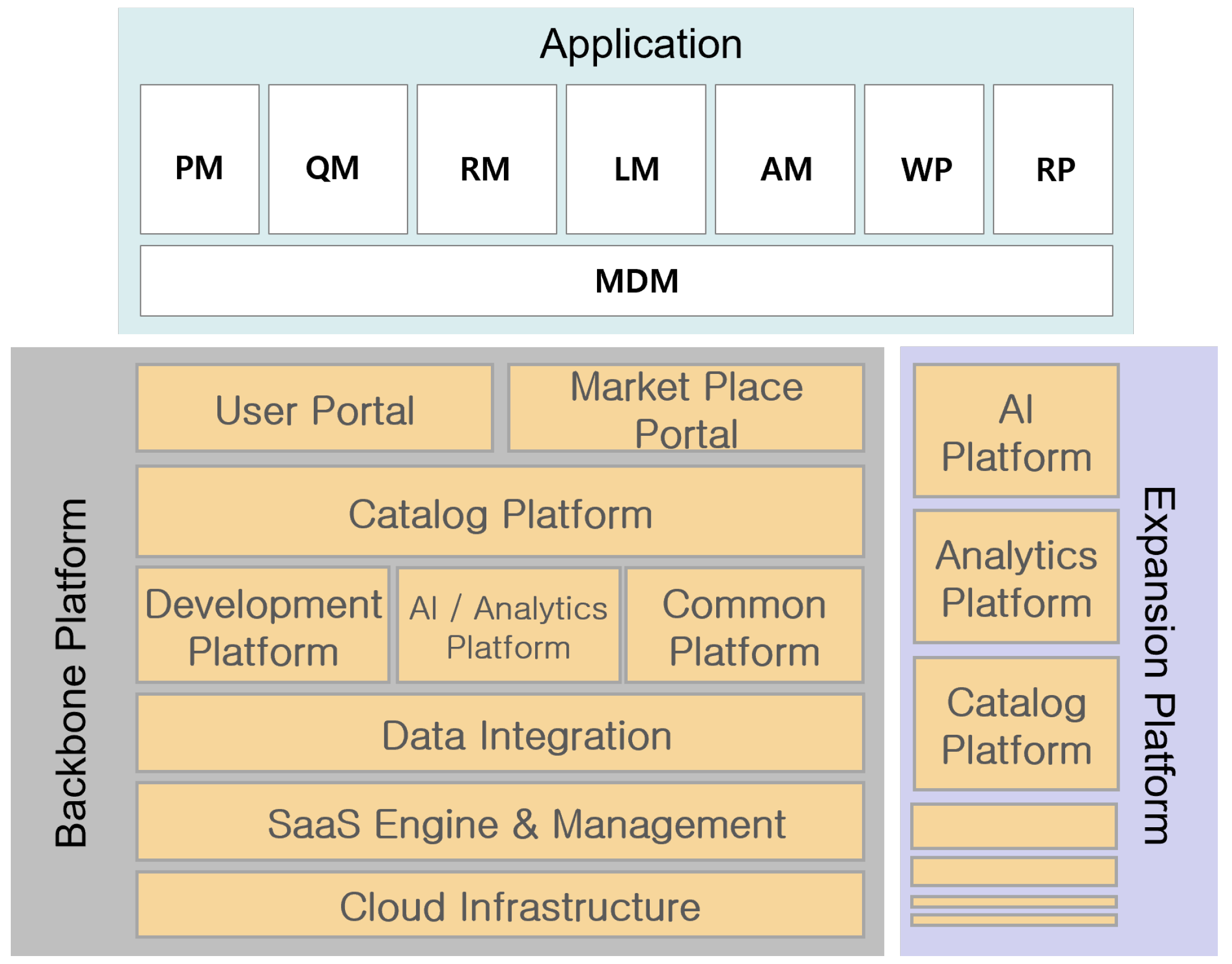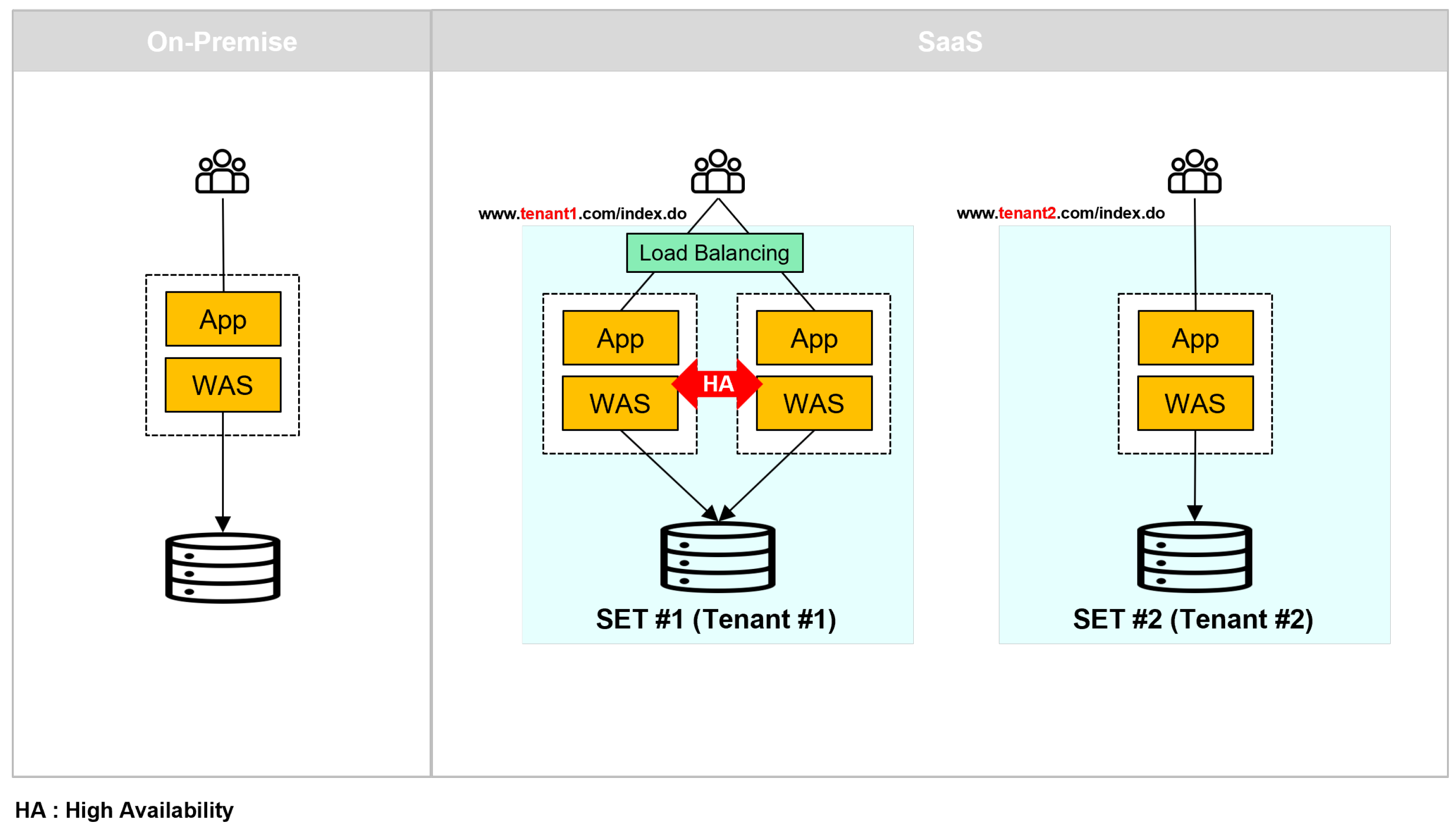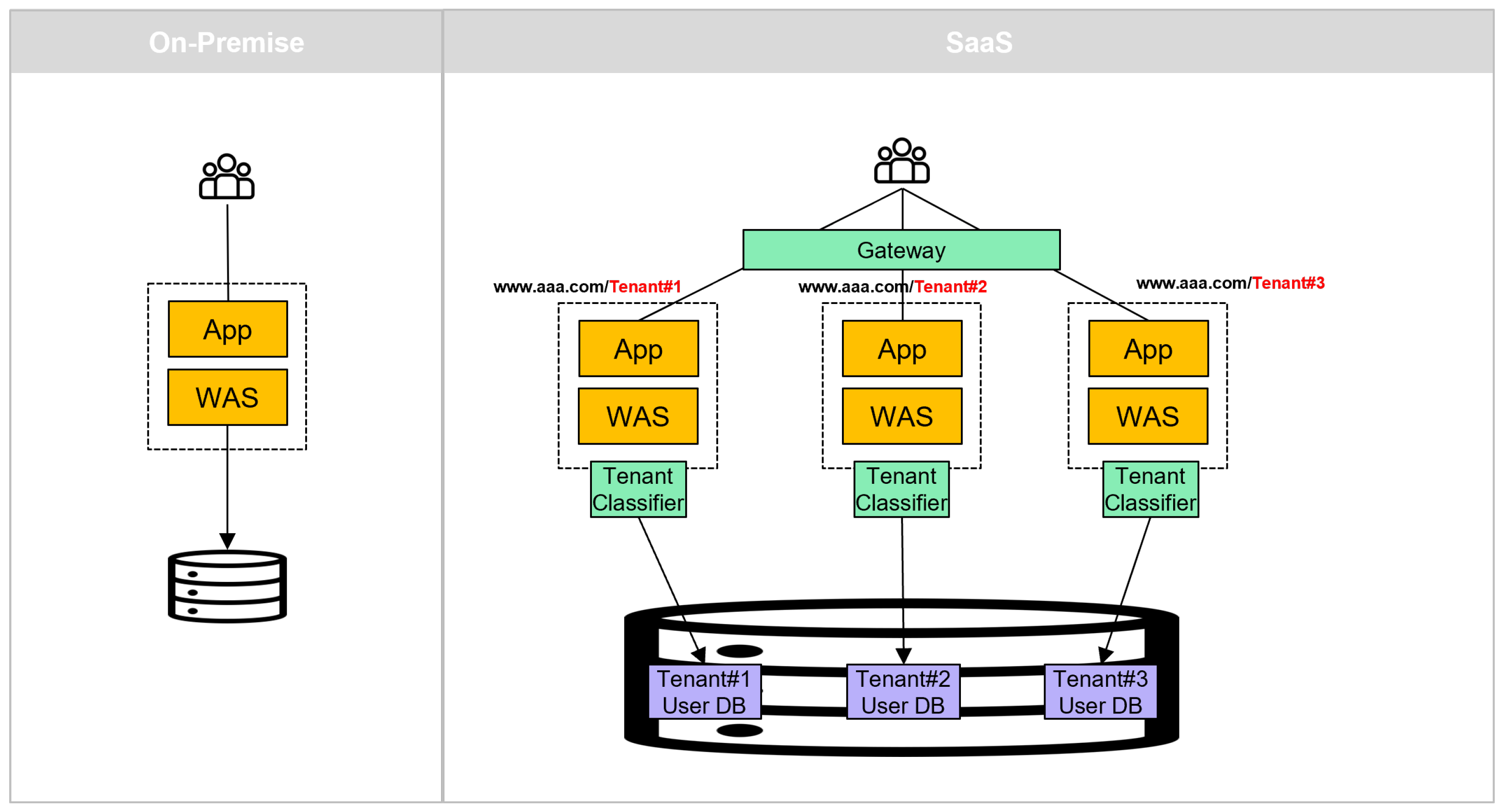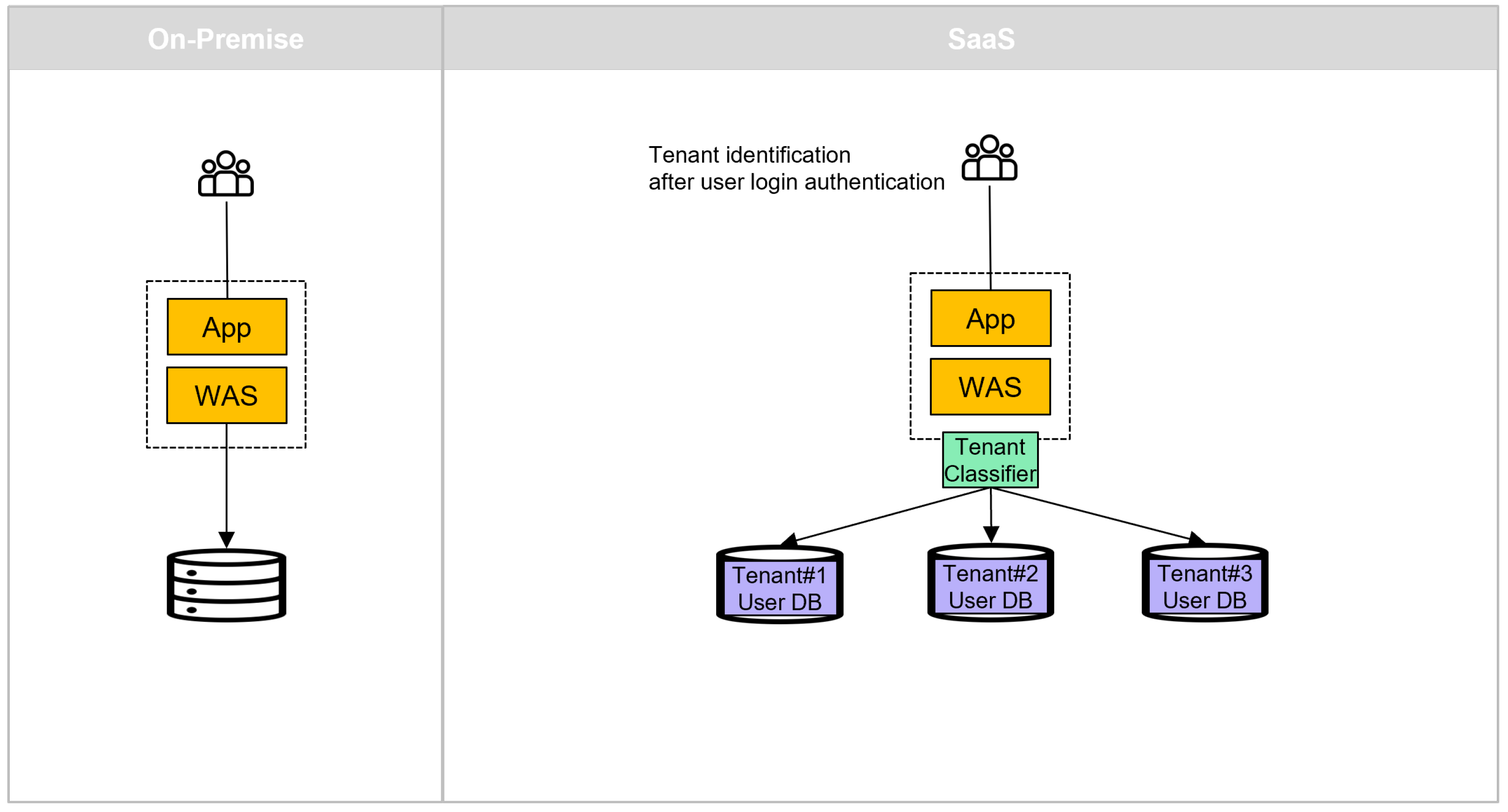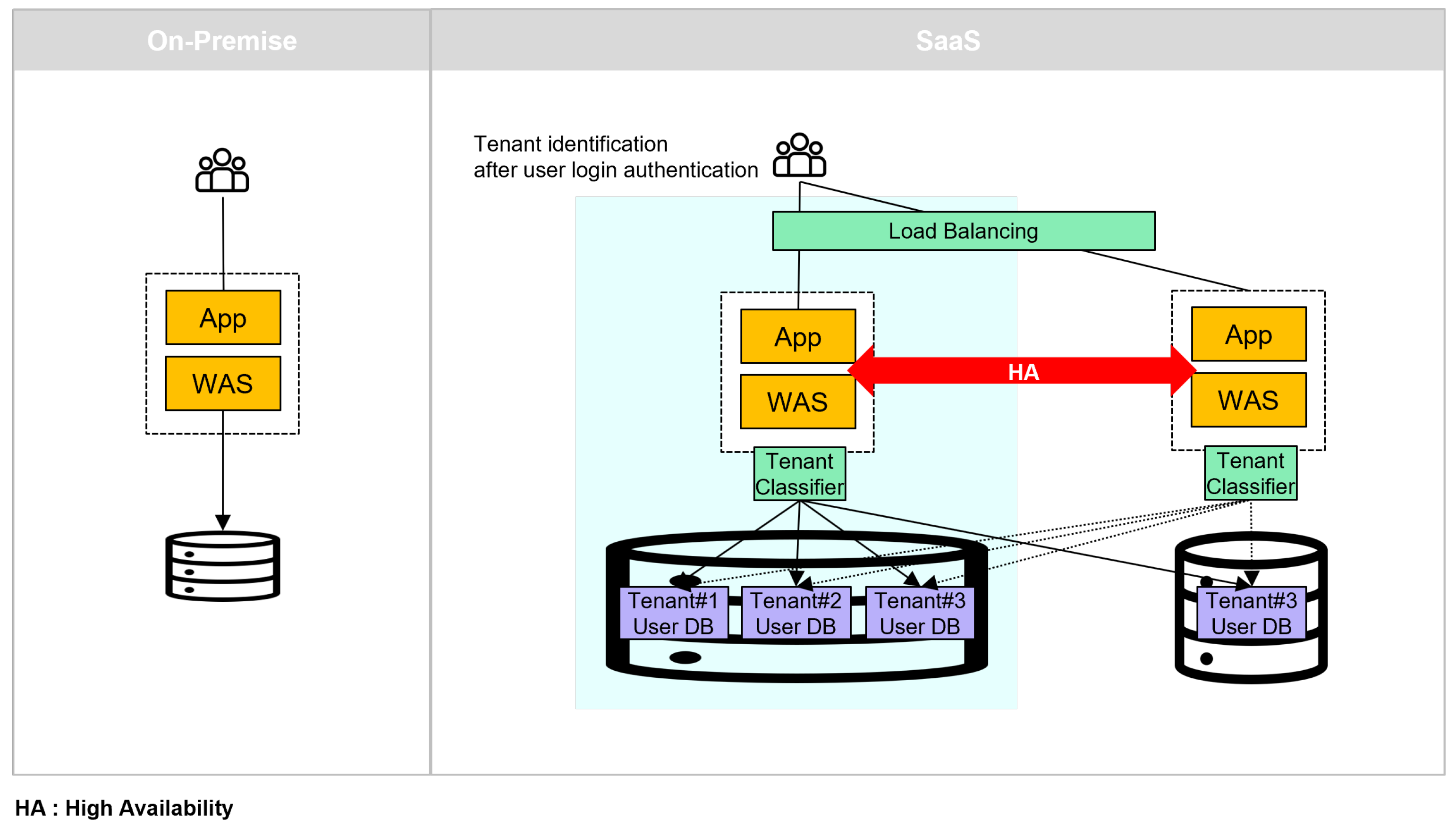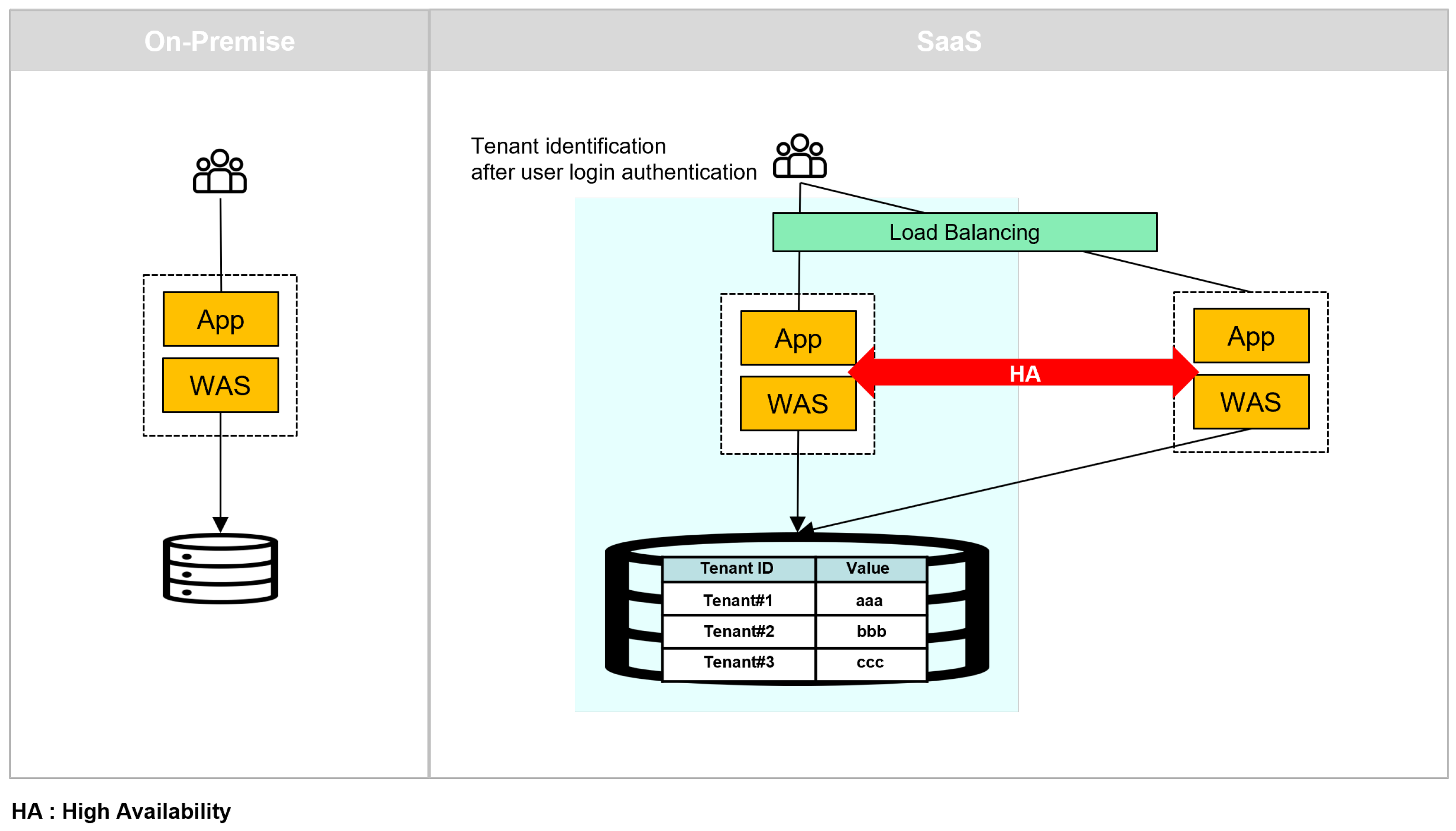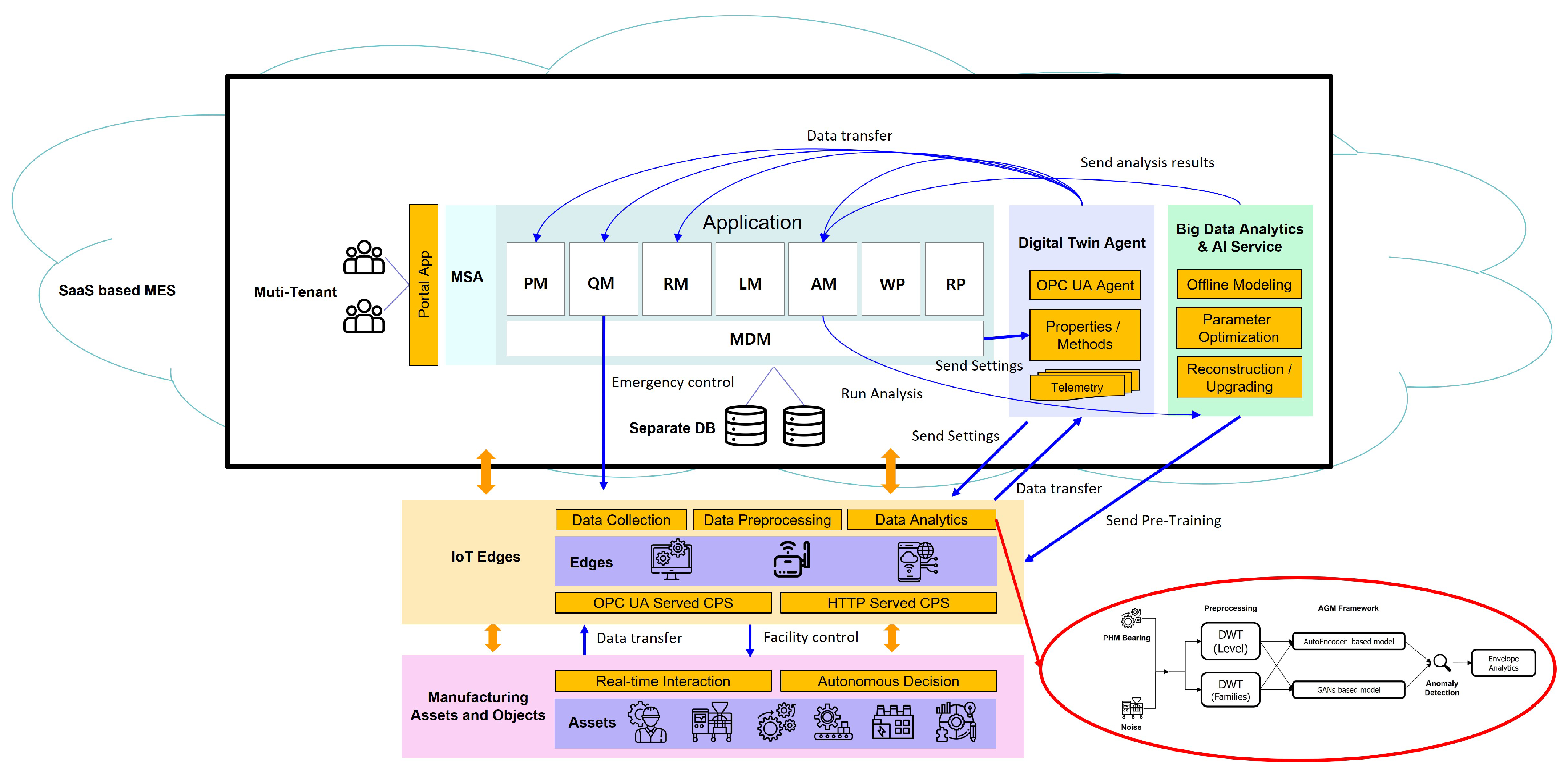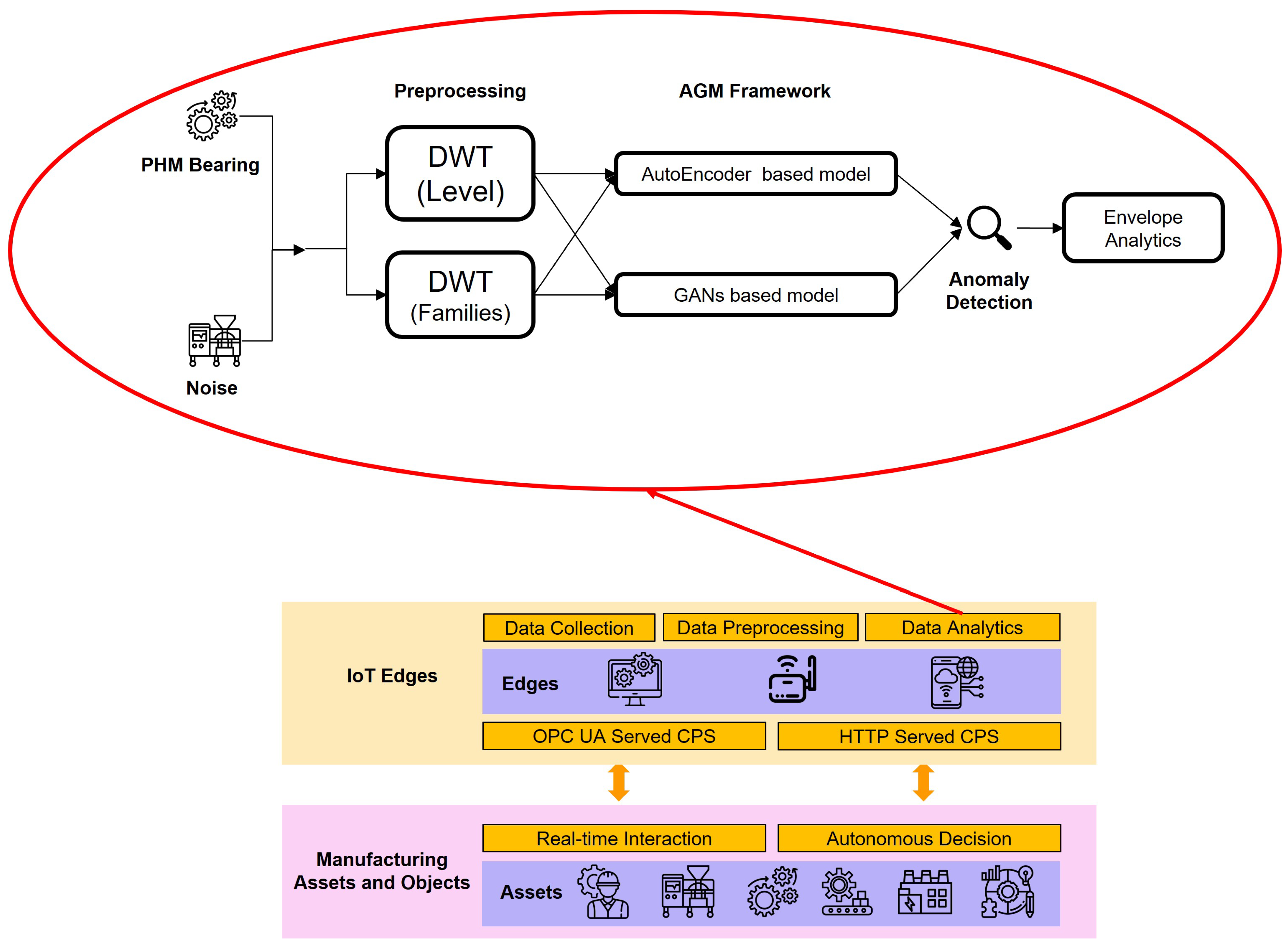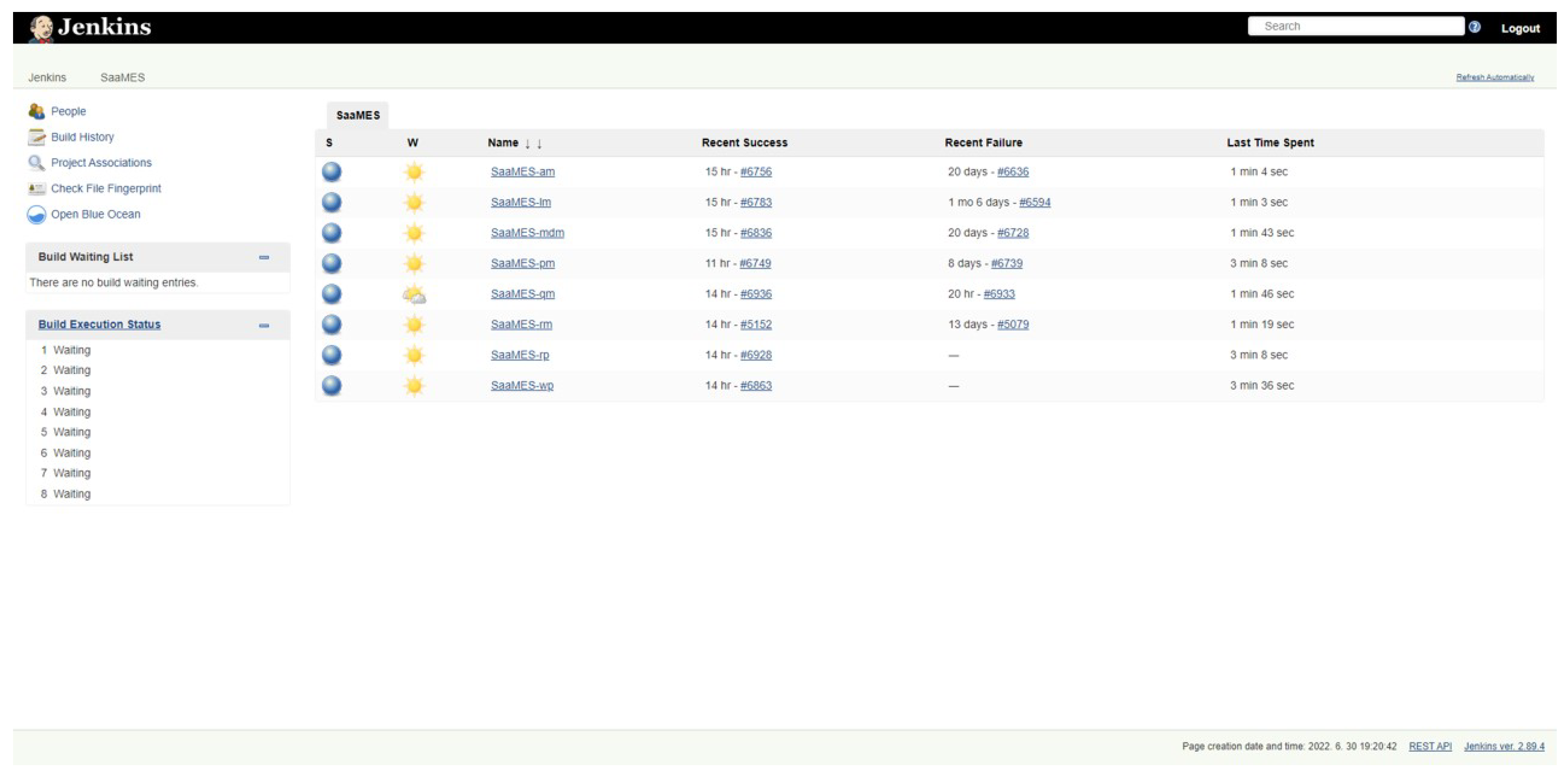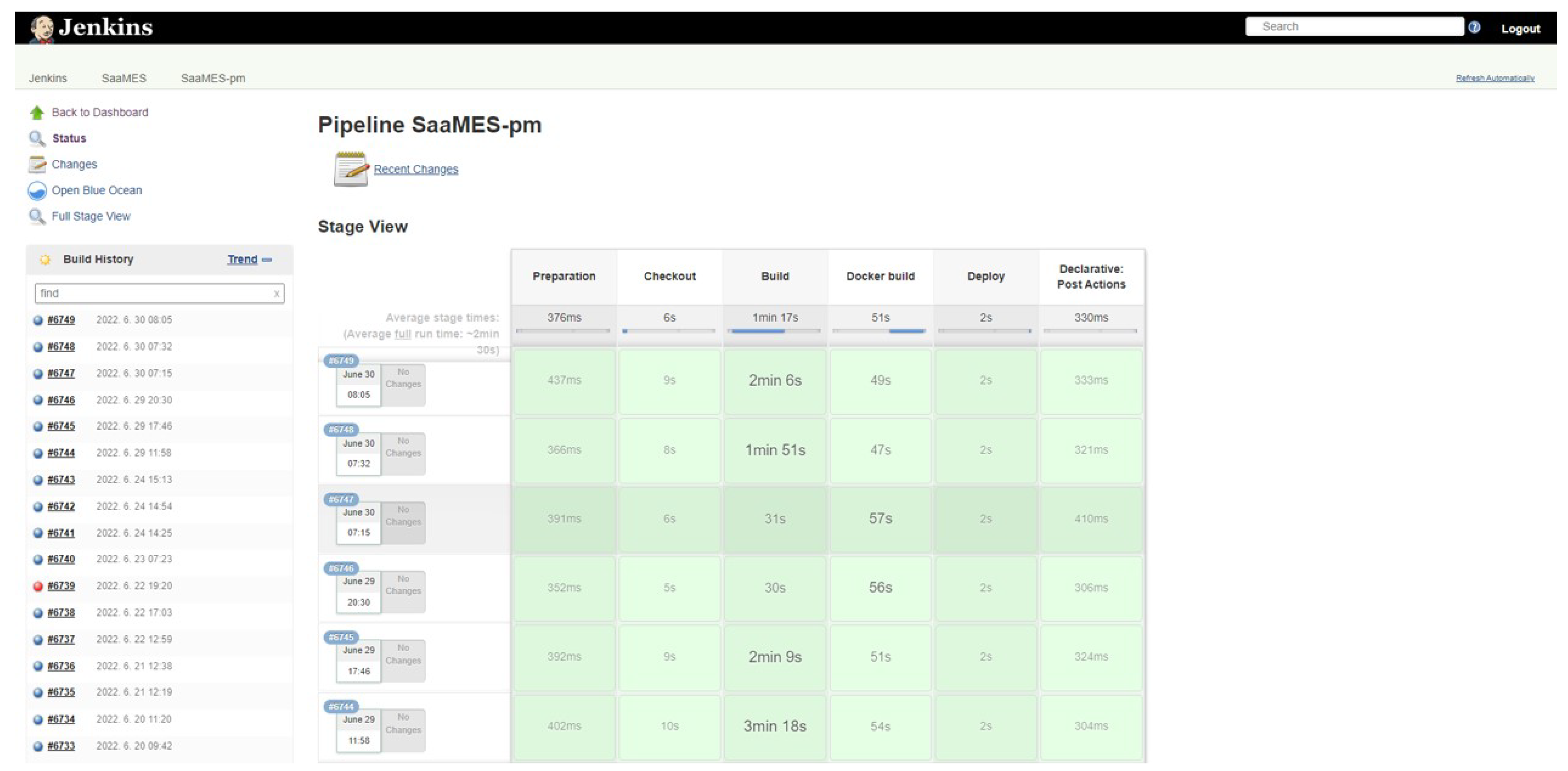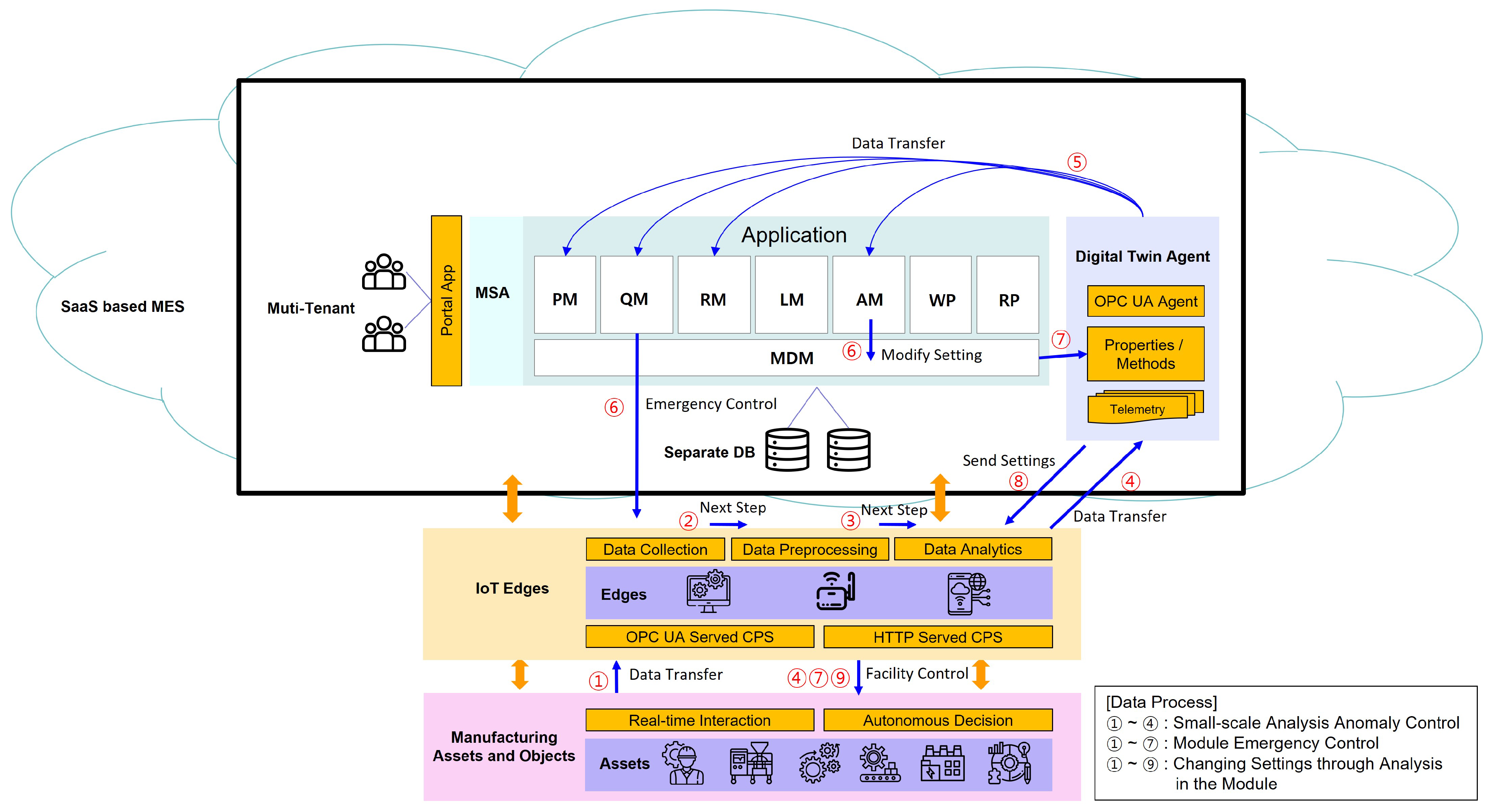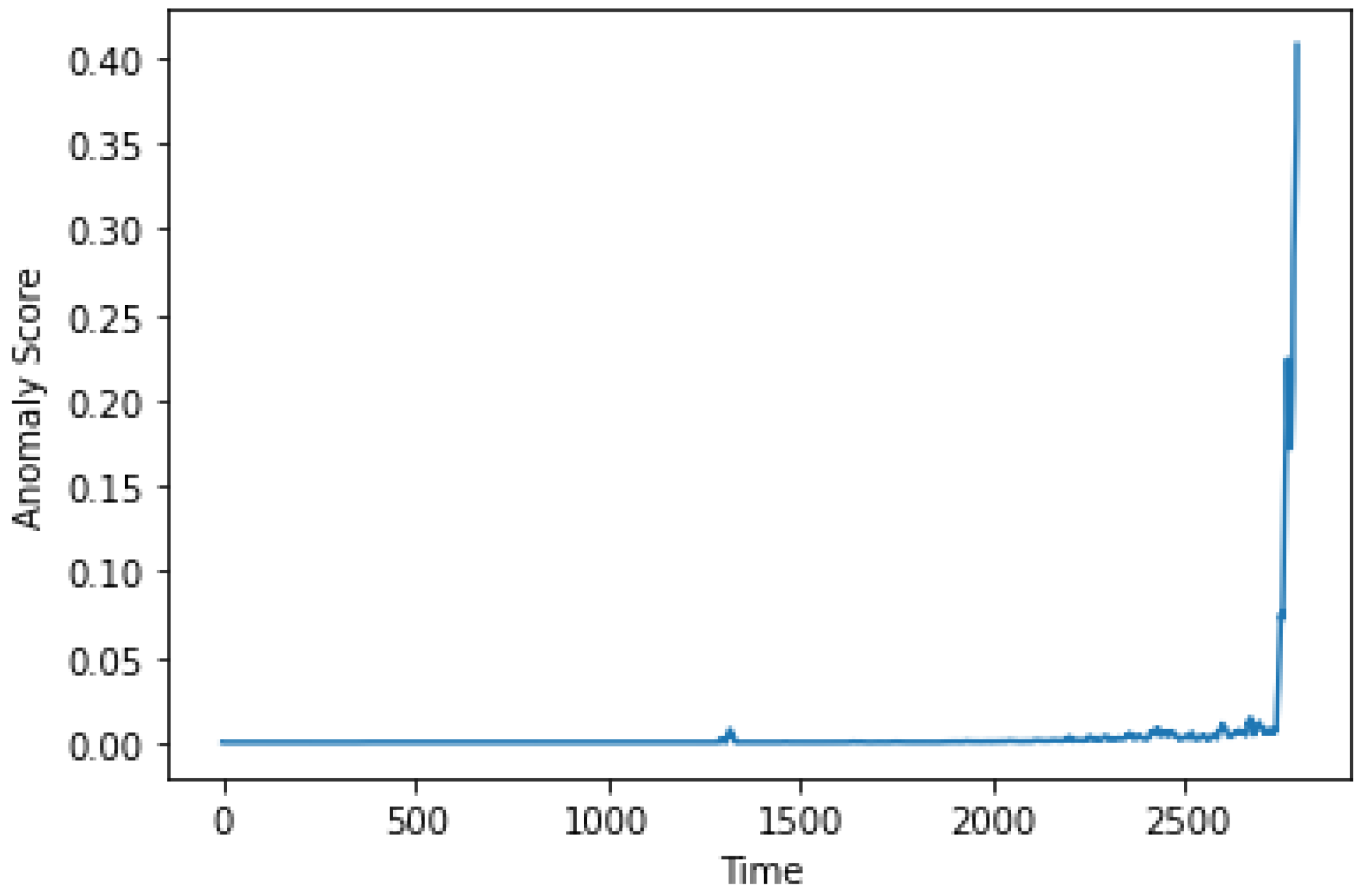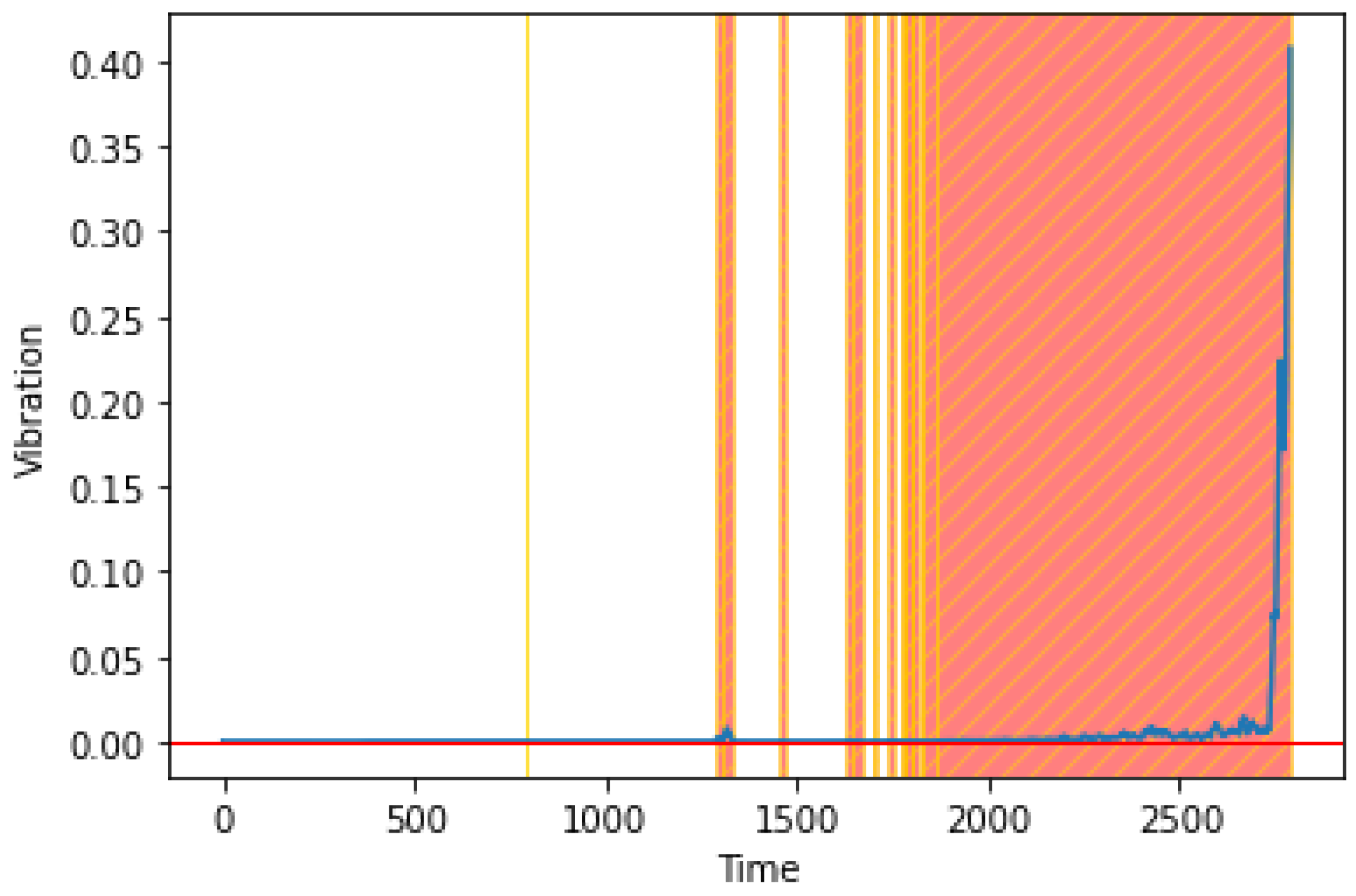1. Introduction
One of the reasons why Cloud Computing technology is focused on manufacturing environments is the Internet of Things (IoT). With the development of [
1], the cost and flexibility of building an On-Premises IT infrastructure that stores and accumulates vast amounts of digital data generated on the shop floor at the individual factory level is inefficient. Another reason is that many Cloud Computing services provide various additional services such as large-capacity big data analysis and artificial intelligence, and if they are utilized, they can be more helpful in implementing smart factories. As a typical software delivery model, Software as a Service (SaaS) allows third-party providers to provide software as a service rather than a product to many users over the Internet [
2]. In addition, with the advancement of IoT, system design with Microservice Architecture (MSA) is suitable to provide rapid change and dynamic resources due to many issues such as technology heterogeneity, resource constraints, and interoperability [
3] and Multi-tenancy Architecture (MTA) has been adopted as a key technology component to transition to SaaS architecture [
4]. Combining IoT and SaaS technologies can improve integration between physical resources and Cloud services.
SaaS application is a service through a subscription model, and SaaS’s provider is an application that hosts one integrated service in the Cloud and makes it available to multiple users over the Internet [
5]. SaaS is appropriate for third-generation software engineering and is considered a package of development, execution automation runtime resource sharing management, and security [
2]. The benefits of moving to an SaaS business model are as follows. First, the application of predictable long-term subscription-based revenue models improves business value. Second, rapid and flexible technology implementation and response improve agility. Third, the transition from On-Premise to code-based improves maintenance productivity. Fourth, rapid upgrades accelerate innovation. Fifth, the user’s barriers to entering the service experience are lowered, and the overall customer experience is improved due to the competitive usage fee, thereby improving the value of the service. Currently, it is serviced by many SaaS applications; examples include email services, Cloud storage services, collaboration tools (Slack, Notion, Zoom, etc.), and YouTube [
6].
Compared with traditional on-premise software, SaaS provides three key benefits [
7]. First, because it is not a large initial investment, but rather a usage-based payment approach, the monthly investment is relatively low. Second, by removing specialized personnel who manage your software and underlying infrastructure, you can reduce human and financial pressure on your company. Third, you can save money and time by instantly accessing the latest applications and services without having to bother with development, installation, and testing. Each application domain has numerous SaaS vendors, so customers have more flexibility in IT decisions. Since you have not invested in infrastructure, you can always move to another vendor if needed [
8]. In the long run, the advantage of the SaaS transition in terms of cost and profit can be confirmed not only in the case of the previously applied companies but also in the model announced by the technology-as-a-service playbook 2016 (TSIA). The Fish model in
Figure 1 demonstrates that in the early stages of business transformation, the return curve temporarily falls below the cost curve due to investment costs, but eventually, over time, operating costs decrease, revenue growth increases, and revenue lines rise.
There are two reasons why an MES design based on SaaS requires an MSA. First, it is easy to respond to rapid changes. Unlike traditional application developments, SaaS provides granular services based on the purpose of the service and the ever-changing needs of the customer. As a result, SaaS must deliver higher quality services than On-Premise systems. Existing On-Premise-based MES mainly used the form of building and releasing as a single package, but MES with MSA for each module and class can respond sensitively to customer requirements and deliver only necessary services to the container, so SaaS-based services are cost-effective. MSA [
9] is a distributed system solution after Service-Oriented Architecture (SOA). MSA has greater advantages in application system design, functional module development, and subsequent maintenance work compared with traditional SOA architecture. The traditional way we used it was a monolithic architecture in which the system was lumped together. Because the entire application is one, the entire application needs to be built with even a small modification, resulting in longer build and test times, and increasing the use of certain features, making it impossible to selectively scale, and a single service can impact all services [
10]. MSA is attracting attention to solve these problems. MSA is a method of designing a single program into a small combination of services by dividing it into each component. Each component is implemented in the form of a service and communicates with other services using the API. Each service is an independent server, and because it is not dependent on other components, it deploys independently. In addition, each component is developed as an independent service, allowing for partial scaling, even as the usage of certain services increases. It is suitable for the SaaS subscription model by quickly responding to customer requirements through service segmentation and distribution processing, and selecting optional functions [
10,
11].
Second, distributed processing is needed due to the explosion of data. MES is most sensitive to accuracy and works in real-time on the shop floor. Since everything in smart factories is data-driven, problems can occur in the production process if the connection is not smooth, and solutions should be prepared. Furthermore, it is necessary to increase the manufacturing utilization of such big data because it accumulates a vast amount of data collected in real time through sites, markets, and social networks, and can benefit more from business analysis and artificial intelligence. For this, it is essential that real-time processing is smooth [
12]. The weakest part of Cloud-based SaaS is real-time functioning. To compensate for this, the network field’s development has been repeated. Today, the network-side solution to ensure real-time Cloud-based services is considered a 5G network. However, the speed of the network is not the only solution. There may also be issues with network equipment and Cloud services in the field. Research has been conducted to optimize services and flexibly select services in the manufacturing Cloud for IoT and big data processing [
13]. MSA is not just an architecture for application segmentation. Research on the micro-service-based IoT system was also conducted to process big data [
3]. A system close to the MSA is the IoT Edge. Optimization and segmentation of SaaS applications are important, but optimization and segmentation on the shop floor are also important. In addition, if these two areas are vertically integrated, it becomes the overall MSA of the Cloud and shop floor.
The use of IoT Edge was noted for real-time use of big data in the Cloud base [
12]. Cyber-Physical Systems (CPS) are systems that are divided between the cyber and physical worlds connected over a network and are generally associated with the concept of IoT [
14]. The development and many applications of distributed industrial CPS IoT applications have significantly changed manufacturing systems and provided an opportunity to further optimize and refine automation systems to encapsulate them. IoT and Internet services present a vision of a smart factory where CPS monitors physical processes, creates virtual copies of the physical world, and makes distributed decisions [
15]. The realization of CPS for factory automation requires tools on the shop floor that can support distributed systems. The focus has shifted from traditional single, professional-based, independent engineering tools and methods to a unified Cloud-based tool/system infrastructure. Smart objects, detection, and operational capabilities of smart factories are being developed and applied to various smart sensors, devices, and facilities during manufacture along with the development of ultra-small sensors aimed at small, low-cost, low-power, and high-precision. Through this, vast amounts of data have been digitized at the same time as IoT development. For distributed processing, IoT Edges are connected to the shop floor and serve as intermediate hubs for transmission to Cloud-based SaaS systems. Actively utilized IoT Edges can be directly connected to the shop floor and the Cloud, reduce network usage, and provide very resilient and powerful capabilities to handle manufacturing big data. In addition, after gaining some knowledge or insight through big data, real-time measures are taken to improve productivity or reduce losses, compensating for the lack of real-time performance of Cloud-based SaaMES.
There are two reasons why it is most efficient to separate applications and efficiently distribute IoT data through SaaMES’ MSA. The first reason is the efficiency of subscriptions [
15]. The tasks required vary depending on the characteristics of the manufacturing site and the level of users, so they are divided by task so that users can subscribe efficiently. The second reason is the efficiency of data processing and virtualization [
16]. Because the data used by each user varies from service to service, the process of processing internal data and IoT data is also distributed by task, which facilitates maintenance and additional virtualization of applications.
The last technology needed to perform SaaS-based services is MTA. In a system, a tenant is a user who uses shared resources. In SaaS, it is an architecture used by multiple tenants to share and use one application [
17]. Tenants can be tenants of one user or organization or multiple tenants for the same purpose. Because the application is shared and used, the requirements of other tenants can be shared and provided. Even if multiple tenants use a common application, the service cannot conflict with each other because it is managed separately from the SaaS base to the container [
18]. Depending on the applied MTA, the application and database can be shared and used and depending on the setting, they can be used separately from tenants [
19]. When designing SaaS-based systems, MTA must be performed according to the nature of the application. Depending on the nature of each system that shares or isolates applications and databases from each other, you should initially consider the power of the On-Premise to SaaS transition. In this study, the characteristics of SaaS transition are divided into five groups to be considered when establishing power, an MTA suitable for MES is found, and strategies are established for transition.
SaaMES is SaaS based, and its biggest advantage is that it can effectively reduce costs. With MSA, you can select and use only the services you require, reducing costs and waste of resources by not putting unnecessary services in containers. In this study, we summarized the considerations when switching from On-Premise to SaaS with MTA, and proposed the optimal MTA approach for MES to reduce the complexity of instances and reduce costs. We also made it easy to install and upgrade by allowing services to multiple users in a single instance. We reduce the use of resources in the network and Cloud by preprocessing and entering various large numbers of data through IoT Edge, ensuring real-time performance so that production progress is not disrupted in the event of Cloud problems. We confirmed that simple analysis models are possible on the IoT Edge and demonstrated that executing anomaly detection at the IoT Edge is faster in terms of time than performing in the Cloud, and real-time performance is secured, allowing quick decision-making.
This paper is configured as follows.
Section 2 explains the related work.
Section 3 lists the concepts that support the proposed SaaMES approach, presents an architectural analysis centered on methodological MSA and MTA, presents a standard model appropriate for MES, and demonstrates real-time centered on IoT Edge.
Section 4 explains the experimental description and result on IoT Edge for securing SaaMES real-time performance. Finally,
Section 5 discusses the conclusions and future research plans.
3. SaaMES: SaaS-Based MSA/MTA Model
In this study, we present a SaaMES architecture. This architecture is divided into two primary themes. First is SaaS-based MES architecture. It is crucial to apply MSA and MTA to develop SaaS-based MES architecture. Thus, we apply MSA and MTA to explain the architecture appropriate for MES. Second, securing real time using IoT Edge and detecting abnormalities through simple analysis. For Cloud-based SaaS services, the role of IoT Edge is critical in manufacturing execution systems that need monitoring and control of manufacturing processes in real time. We introduce experiments on the anomaly detection model through a small-size dataset and measure the processing time, including each analysis in the Cloud and IoT Edge for the availability of real-time performance.
3.1. System Architecture
As shown in
Figure 4, we propose SaaMES. It is divided into SaaS-based MES part of the Cloud, IoT Edges, and Manufacturing Asset and Objects part of the shop floor. Each tenant can access MTA’s own system through the Portal App. You can use the app that you charged through the MSA. In the Digital Twin Agent, the OPC UA Agent collects data and sends it to tenant-specific systems. Depending on the settings of each tenant, the settings of various Manufacturing Assets and Objects are stored through Properties/Methods, and connected to IoT Edges on the shop floor through Telemetry to receive data. Properties/Methods communicate with tenant-specific DBs for real-time settings. In addition, the changes in IoT Edges on the shop floor through Telemetry are matched in both directions to match the settings to the shop floor in the tenant-specific DB. Data on changes in the shop floor other than IoT data are entered into service without going through the Digital Twin Agent in a way using MQTT. Big Data Analytics & AI Service is mainly responsible for large-scale analysis, fine-tuning parameters, and upgrading the analysis model of IoT Edges. Offline modeling performs AI analysis with big data or pre-training of big data to perform data analysis on the shop floor. Parameter Optimization optimizes parameters to increase the accuracy of the analysis of Offline Modeling. In Reconstruction/Upgrading, the analysis is performed with optimized parameters. In addition, the pre-trained analysis model is sent to IoT Edges to enable small-scale analysis models on the shop floor.
3.2. MSA in SaaS-Based MES
The advantage of SaaS-based services is that the initial investment and maintenance costs are low. However, if we customize and service SaaS-based services for each factory, we cannot take that advantage. Thus, not individual customization at the beginning of development, but general customization with factory know-how by industry and MSA, which divides each service, are crucial technologies to service SaaMES. In this study, we propose a standard architecture by applying the classification of the manufacturing execution system using the manufacturing approach and MSA. When switching from On-Premise to SaaS service, building and distributing as one image in the existing approach does not take advantage of SaaS. Previously, different versions of the service were offered by managing each customer’s version. However, while switching to SaaS, it is critical to apply MSA and identify the characteristics of each customer to offer customized services. In addition, with the development of IoT, many data with each characteristic such as production, quality, logistics, and facilities are generated, and smart factories are being developed with the aim of fully automating factories through that data. By modularizing each characteristic through MSA, it is possible to manage more efficiently through resource management distributed within SaaS. As shown in
Figure 5, virtual servers can be divided and provided on a customer-by-customer basis by the management of tenants in SaaS. The basic purpose of SaaS is to reduce costs by fully using the services that the service provider offers. However, the approaches employed by each factory are slightly different, and there are numerous places where the process is independently established and employed according to domain know-how. This is also why versions of the service were managed differently for each user in one solution, as shown in
Figure 5. To become a universal system, it is essential to offer common functions and provide different support through domain know-how. Furthermore, it is crucial to change the type of work on the site so that customization does not produce a version appropriate for a specific plant and the process of a manufacturing execution system divided by the manufacturing industry can be applied. It is possible to generate optimal productivity by leading manufacturing innovation by applying optimized processes to the manufacturing field.
When SaaS-based MES is combined with functional MSA, the following advantages can be assured. Users pay as much as they register and employ only the functions they need, and wasted resources because of functions that are not used are reduced in terms of Cloud management. Furthermore, since containers are virtually mechanized and employed for each service, non-disruptive services are possible in builds and deployments. Thus, Cloud service can be managed more effectively than the existing On-Premise approach with the MSA approach.
When switching from On-Premise, the first thing to think about is to separately define what can be used in common and design it by collecting common functions. Applicationally, a common function should be created so that only each module can be referred to for use when it is executed. Likewise, in the database, the standard information table commonly used should be separated and managed by MDM. MDM is a basic application, so it is an essential module to select and use. Therefore, baseline informativeness is designed to be managed by MDM. The next is the separation of work areas. Basically, it separates the areas of work based on the statistics actually used in
Figure 3. The important point here is that each module should be able to perform independent tasks. The reason is that even if only one of the modules of SaaMES is selected, it should be possible to execute. However, since production must be possible for the purpose of SaaMES, PM, QM, and MDM are essential systems. When it is separated by task, the DB connection of each module must be conceived independently. The reason is that DBs used may be different from each other, so they should be scalable. For example, since there may be an external system-linked service, it should be configured and managed so that it can be configured for each module. Resources for each module can be set up by checking the shop floor for each tenant.
Looking at
Figure 6, the Backbone Platform is commonly applied. Each customer employs a different amount of service, and the Expansion Platform can be employed by adding a platform that lacks the Backbone Platform. In the application area, Master Data Management is provided as the default application. Additionally, by applying the MSA, the modules were divided by tasks and main purpose. It is divided into Process Management, Quality Management, Resource Management, Logistics Management, Artificial Intelligence Management, Work Place, and Resource Planning. The application may be selected and serviced according to the user’s usage. The Backbone Platform is an area provided by default. Cloud infrastructure is an IaaS that connects networks, virtualization, servers, and storage in the Cloud. SaaS Engine/Management is an area where container services and monitoring are possible. Data Integration is an area where data collected by the Digital Twin Agent and interfaced data are collected, loaded, processed, and stored. Development Platform offers development environments such as IDE, UI Framework, and DevOps. The AI/Analytics Platform offers an analysis engine and model development environments such as analysis algorithms and data visualization. Common Platform offers basic services such as user rights, authentication, logging, search, and encryption. Catalog Platform offers catalogs such as APP/UI, data, analysis models, and APIs. The User Portal provides platform home configuration and service UI Portal for each user. The Market Place Portal provides users with the ability to purchase and use MSA-enabled modules in real time. Expansion Platform is a service offered by the Backbone Platform, which is provided, only for users who want additional features or enhanced specifications. For example, if we want more than basic AI functions, we can receive additional functions through service contracts. Furthermore, if the service is not provided because of the basic specifications, additional services are provided as an advantage based on the Cloud, so stable services can be employed.
3.3. MTA in SaaS-Based MES
As for the multi-tenant characteristics, a single-tenant application is a structure in which software is installed for individual tenants, and a multi-tenant application is a structure in which tenants share software and use it together. Therefore, it is a structure that can be expected to reduce the overall operating cost (such as license and operating personnel costs).
Cost reduction
Easy to analyze and fuse data
Simplify the software updater process
Focus on business processes
Delivers efficient, sustainable scalability
Service failures affect all tenants when providing single instance-based multi-tenants
Restricts the delivery of specialized features per tenant and increases complexity in delivery
The advantage of the multi-tenant approach is that it can increase resource utilization, while it affects all tenants in the event of a service failure. Therefore, in order to prepare for such a failure, hedging measures such as distributing applications to multiple instances should be considered.
The main considerations in terms of application design are as follows. First, it is necessary to provide a means to distinguish tenants who are using the application from within the application. Second, the behavior of one tenant should not affect the behavior of another tenant (transaction isolation). Third, the application should present a programmatic means to enable the isolation of data by the tenant, and the application should be logically and physically partitioned (data isolation). Fourth, through application partitioning, different levels of service for each tenant, differences in many characteristics must be provided.
SaaMES manages the multi-tenant as a configuration. A plan to efficiently manage various tenant configurations should be prepared, and when changes occur, they should be reflected at runtime. A configuration file of a typical single tenant application exists inside the application.
MTA is crucial for SaaS-based services. Multi-tenant architecture refers to the principle of building a software architecture for applications implemented to accommodate multiple tenants in the same infrastructure. If the application upgrade process itself has numerous instances, complexity and operating costs increase as the number of customers increases. Thus, in a single instance virtualized application, a multi-tenant application that can serve all customers with the same OS, the same SW, and the same specifications become the standard for SaaS. This eliminates the problem of modifying and redeveloping applications for new customers. Furthermore, the time-to-market of the service can be secured to provide applications to meet the needs of the market as a subscription-based service. In other words, MTA allows one logical database instance to be shared, business logic can be applied to all users, and these technologies are crucial for providing SaaS. In this study, to determine the appropriate service type for MES, the service types for each multi-tenant were classified into five types, as illustrated in
Figure 7, and the characteristics of each type are summarized in
Table 1.
Figure 8 shows the SET method’s architecture in the physical independence method. Physical resources for each tenant, which are previously capacity-calculated in consideration of users, can be accessed by assigning an access URL for each tenant without SET configuration and modification of existing applications.
Figure 9 shows the architecture of the provisioning method in the physical independence method. The independent infrastructure configuration minimizes the modification of existing applications and adds tenant identification logic and routing logic. Provisioning with the same source and image (machine.container) per tenant is effective for management.
Figure 10 shows the DB separation architecture in a logically independent method. Configure an independent DB for each tenant and add tenant identification logic and routing logic to the existing AP. Existing data can be used as it is, existing AP modifications are minimal, and DB security is outstanding.
Figure 11 illustrates the architecture of DB schema separation in a logically independent method. All tenant identical WAS/DB instances are shared, DB users and schemas for each tenant are created, and then data are processed for each DB user.
Figure 12 shows the architecture of DB column separation in a logically independent method. Share all tenant identical WAS/DB instances, share the same DB schema within the DB, and process data based on tenant ID.
As demonstrated in
Table 2, it is essential to establish an SaaS strategy and select a conversion type according to the cost, time, operation efficiency, business requirements, and technical maturity of resource separation and sharing.
SaaMES strategically applies the logically independent DB separation and DB schema separation approaches in parallel for performance and security. Since the manufacturing plant’s data are sensitive for security, DB is provided separately for each company. However, if several factories within the same company provided services, the factory is divided into DB schemas and access by each user is possible. Each company does not need to separate schemas from one DB, but as IoT technology develops and big data use increases, data may increase and cause speed reduction when inquiring in one schema, so it is appropriate to logically divide the storage space.
As for the multi-tenant application resource configuration plan, the components of the application consist of the WEB, WAS, Connector (WEB ↔ WAS), Identification System, and Integration System by layer. In the tenant application, these factors should be properly partitioned to provide tenant-specific services so that they do not interact. Application partitioning affects scalability, availability, and management. The largest range of tenant-specific separations is one subscription tenant and group multiple tenants in a subscription, which separates tenants by subscription of a multi-tenant application. Tenant separation on H/W and S/W is one tenant per Cloud service (VM), group multiple tenants in a Cloud service (VM), and group multiple tenants in a WEB/WAS/other elements.
As for the multi-tenant data source configuration plan, if a multi-tenant application has a different data source for each tenant, the application should be able to find the appropriate data source at runtime according to the tenant information. In addition, if a new data source is created, it should be recognized and available to the application. For a typical Java Enterprise application, WAS uses a database and Connection Pool to connect, and the application (Framework) uses the connection pool declared in WAS to look up as JNDI. In other words, it takes the form of using a pre-declared data source in WAS. In order to provide each service, access to data sources by tenants must be considered. This approach requires binding and using the appropriate data source according to the tenant ID within the application in a way that each tenant has a separate data source (account). In other words, the data source must be dynamically routed. We look at these Dynamic Datasource Routes based on the Java Framework, Spring. In the case of data access, the routing method of finding the appropriate data source according to tenant information per request would be suitable for OLTP applications, and swapping data sources according to tenant information is an easy way to process data from one tenant.
Finally, for a multi-tenant log configuration scheme, logging should have separate log files per tenant, and certain tenants should not be able to access log files from other tenants. Since multiple tenants use the service for multi-tenant applications, the information of the tenant must also be output when the log is output. This should only be valid while the request is being processed and should not affect between threads. In addition, if a log file corresponding to a tenant is routed and each file/directory is classified, log file management becomes easy. For this logging, logback, and log4j use a Mapped Diagnostic Context (MDC). It can be used for logging by setting the tenant ID to the MDC at the start of the request and removing it from the MDC at the end of the request. Setting up when a request starts and removing it when it ends is only valid while the request is being processed, thus preventing the use of false data even in WASs that recycle the thread. When managing logs by the tenant through Logback, it should not be forgotten that the MDC should set it up at the beginning of the request and erase the setting at the end of the request. WASs that share ThreadPool can cause incorrect references.
Considering the above method, SaaMES applied with MTA is applied by applying a logical DB separation and provisioning method. Then a method for multi-tenant testing and monitoring is needed to ensure that it is applied well. In actual application, the method was defined and performed. In addition to functional/non-functional testing of general applications, additional tests such as access control of resources by the tenant, customization by the tenant, and backup/recovery of tenant-specific data are required. The test of a multi-tenant application will be the same as the single-tenant application and will be divided into functional and non-functional tests. In addition, a test specialized in a multi-tenant application is required. The multi-tenant application requires testing for isolation in all respects. In addition, testing in a runtime environment for tenant-specific customization is required. In general, customization involves code modification or application redistribution, but in multi-tenant applications, these modifications should not affect other tenants. Therefore, a test item is needed in terms of multi-tenant application development and operators.
3.4. Real-Time Control in IoT Edges
With the development of IoT, centralized methods are inefficient. Therefore, IoT Edge has been proposed for distributed processing on the shop floor. Simply the distribution method of the shop floor does not completely improve centralization. As a result, MSA can be deployed in SaaS-based MES to select and use per-tenant action usage and simplify resource management by distributing shop floor data across modules. In addition, if the data of a particular task grows rapidly, it can efficiently manage resources by adding modules to docker containers, an important technology in the Cloud. We propose IoT Edges because there are more network traffic and connection pools due to the rapidly increasing digitized data of the shop floor. The aspect of resource efficiency is also important, but the real-time aspect is also an important factor in creating a real-time-based CPS of the developed smart factory.
In
Figure 13, a node is a set of general PC levels in the area of IoT Edges. Data transmitted via OPC-UA and HTTP in real time from Manufacturing Assets and Objects are collected and preprocessed, and then refined data is sent to SaaS-based MES to reduce the load on SaaS and network resources. The Digital Twin Agent exists to receive data transmitted from the IoT Edge by the OPC-UA. Each type stored in Properties/Method is split into Telemetry and remotely connected, and the received data is collected from the OPC-UA Agent and sent to the promised module for each application divided into MSA. The data sent to each module are processed by each business process and entered into a separate DB. The Digital Twin Agent connects to IoT Edges with the promised definition with the settings stored in the MDM of the application and sends them according to the data transfer rules. When the recipe settings of the Asset are changed from MDM or the parameters of Big Data Analytics & AI Service analysis results are verified by the AM module and the settings are stored in MDM, the Digital Twin Agent sends the changed settings of MDM to IoT Edges. The recipe settings required for the Asset are sent from IoT Edges to ensure that production is not disrupted.
In the process of preprocessing data, IoT Edges detect state anomalies in the Asset and alarms and controls data outside the Upper Specification Limit (USL)/Lower Specification Limit (LSL) in Data Analytics. Small-scale data analysis is possible on IoT Edge. Large-scale analysis and initial learning models are run on Cloud; however, in the case of small-scale analysis where the learning model is completed, it can be processed by IoT Edge to control assets in real time. Furthermore, the individual reference information needed for production progress is stored on IoT Edge in case of unavoidable connection to SaaS-based MES, so that the production process is not disrupted in case of an emergency, and the server sends loaded data to prevent loss of production data.
The role of IoT Edge in SaaS-based MES is a crucial area of SaaMES for securing real-time because of efficient data volume, network resources, and network connections. Launch SaaS-based MES with MTA and MSA, and confirm that data is transmitted to each module and transmitted to the module that became MSA. A processing time comparison experiment using anomaly detection through small-scale analysis is conducted to confirm the need for IoT Edge. We modeled and examined the vibration of the bearing with anomaly detection, and experimented with whether real-time control is possible through real-time anomaly detection in IoT Edge, as illustrated in
Figure 14.
5. Conclusions
In this study, we mention the limitations of the existing On-Premise approach MES and propose SaaMES that combine SaaS-based MES with MSA and MTA, and SaaS combines real-time IoT Edge to maximize its advantages. In addition, resource management is an important task due to the separation of the application through MSA with the development of IoT. SaaS application has the effect of reducing initial development and maintenance costs, eliminating unnecessary functional use for users, and reducing Cloud management costs for providers. Furthermore, it is expected that MSA and MTA will be applied so that users can select and employ only the functions they require individually and serve different customers through multi-tenancy.
To apply SaaS, MTA is the most important thing. Therefore, we define five methods of MTA by dividing it into logical and physical independence and suggest a method of combining DB separation and schema separation of logical independent methods, which are MTA suitable for MES, by considering MES characteristics. We also applied MSA to take advantage of the growth of data and SaaS benefits of SaaS. MES’ MSA increases system flexibility and scalability. In addition, with the development of EC, the role of IoT Edges has been expanded and presented, enabling distributed processing not only in Cloud but also on the shop floor. The actual numerical advantage of “real-time response faster” was presented compared with the Cloud environment by applying an analysis model using Autoendcoder and GANs to IoT Edge, which can respond and make decisions through real-time analysis. In other words, it is expected that SaaMES, which complements the lack of real-time Cloud-based SaaS-based MES using IoT Edge, will become the standard for SaaS-based MES in a complicated digital manufacturing environment. As a result, we presented an architecture of SaaMES that presents the vision of SaaS-based MES.
In previous anomaly detection analyses, the analysis results are expected to be inaccurate since the analysis environment of Cloud Computing and Edge Computing using AWS is different. Furthermore, there is a limitation that the advantage of the SaaMES, which is MES architecture with MSA and MTA does not show explicit effects, excluding IoT Edge. Additionally, I felt the need for research on how to measure the capacity of IoT Edges through load testing. Although there are various data on the shop floor, it was difficult to grasp the capacity of IoT Edges because it was not tested with various data. Our future study will focus on demonstrating the limitations of IoT Edge through various analyses, enabling SaaS-based MES to be realized based on measurements of the scale available for analysis on IoT Edge and the architecture of SaaMES presented in the study.
